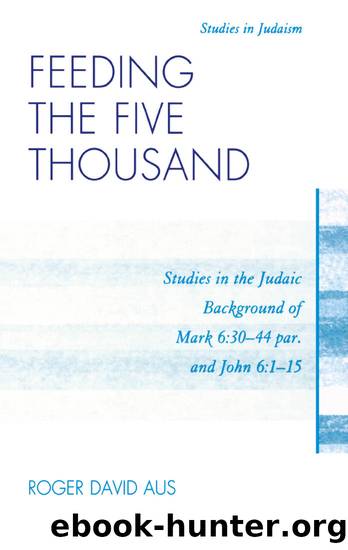Feeding the Five Thousand by Aus Roger David;

Author:Aus, Roger David;
Language: eng
Format: epub
Publisher: UPA
Published: 2010-08-15T00:00:00+00:00
323 Cf. LSJ 961, III.; BAGD 436.
324 Cf. his Das Evangelium des Markus 125, n. 1.
325 Cf. her Mark 324. In her n. 30 she maintains that Israel Abrahams equated ÏÏ Î¼ÏÏιον with the Hebrew . This is wrong; like many other experts, he ended up suggesting . See below.
326 Cf. his Ãvangile selon Saint Marc 168.
327 Cf., for example, Julius Wellhausen, Das Evangelium Marci 52, who also notes other Semitic phraseology in the pericope, and Joel Marcus, Mark 1-8, 408, for the two expressions as displaying âa Semitic idiom.â Matthew Black in An Aramaic Approach to the Gospels and Acts (Oxford: Clarendon Press, 19673) 124 states clearly: âGreek instances of distributive repetition have been adduced, but they are not normal Greek and are decidedly rare. All things considered, the case against Markâs ÏÏ Î¼ÏÏια, ÏÏ Î¼ÏÏια (vi. 39), ÏÏαÏια, ÏÏαÏια (40) as Semitisms is not very impressive.â See also Elliott Maloney, Semitic Interference in Marcan Syntax (Chico, CA: Scholars Press, 1981) 155 on Mark 6:39-40, who, however, exaggerates: âThe repetition of a noun to express the distributive idea never occurs in Greek.â He notes several examples from the MT, Qumran, and Middle Aramaic. Like his doctoral advisor, Joseph Fitzmyer, he rejects out of hand the use of occurrences in the Mishnah and other Tannaitic sources.
328 Cf. his Die Evangelien des Markus und Lukas (Göttingen: Vandenhoeck & Ruprecht, 1846) 68.
329 Cf. § 158 on p. 87.
330 Cf. § 493, (2), on p. 261.
331 Cf. § 248 on p. 130.
332 Cf. for example Julius Wellhausen, Das Evangelium Marci 52; Erich Klostermann, Das Markusevangelium 63; Vincent Taylor, The Gospel According to St. Mark (New York: St Martinâs Press, 19662) 323; and Joel Marcus, Mark 1-8, 408.
333 Cf. Str-B 2.13. I have borrowed several of his examples from the MT below. An expert in comparative Semitics, Carl Brockelmann in Hebräische Syntax (Neukirchen, Kreis Moers: Verlag der Buchhandlung des Erziehungsvereins, 1956) in his section âDoppelungâ (127-28) also notes that as in all Semitic languages, doubling in Hebrew also serves to express distribution; yet it is often for the purpose of intensification. He gives examples from the MT for both.
334 Cf. Sperber 2.96; Harrington and Saldarini have âmany boastful thingsâ (105).
335 Sperber 2.258; Harrington and Saldarini 251. The same is true of 1 Kgs 18:4, where the Hebrew âfiftyâ becomes âfifty by fiftyâ men (Sperber 2.257; Harrington and Saldarini 251).
336 Sperber 2.278; Harrington and Saldarini 270.
337 Sperber 3.416; Cathcart 73.
338 Rieder 2.231; Clarke 259, whom I modify. On , cf. Jastrow 1046. He translates the parallel Hebrew expression as âin groups.â
339 Ibid. Cf. Jastrow 416 on : âcompany, party,â the same as the Hebrew , âcompany, association, party,â both âthe colleaguesâ at school, as well as âthose united for eating the Passover lamb in company.â This is especially important for the interpretation below of âgarden bedsâ and âgroupsâ in Mark 6:40 and 39.
340 Mirkin 5.236; Soncino 3.247.
341 Vilna 58; Soncino 7.230 has âin bands of a hundred or two hundred.â
342 Friedmann 116; Braude and Kapstein 292.
343 I observe no real progression in the terms ÏλοÏ, ÏÏ Î¼ÏÏιον and ÏÏαÏι in 6:34, 39 and 40.
Download
This site does not store any files on its server. We only index and link to content provided by other sites. Please contact the content providers to delete copyright contents if any and email us, we'll remove relevant links or contents immediately.
History of the Jews, Vol. 2 (of 6) by Heinrich Graetz(159)
Nelson, Cary - Israel Denial Anti-Zionism, Anti-Semitism, the Faculty Campaign Against the Jewish State by Indiana University Press (2019)(143)
History of the Jews, Vol. 1 (of 6) by Heinrich Graetz(105)
Feeding the Five Thousand by Aus Roger David;(98)
History of the Jews, Vol. 4 (of 6) by Heinrich Graetz(96)
Great tales of Jewish occult and fantasy : the Dybbuk and 30 other classic stories by Unknown(80)
Sketches of Jewish Social Life by Alfred Edersheim(69)
Judaism and the Challenges of Modern Life by Moshe Halbertal; Donniel Hartman(68)
Elias Bickerman as a Historian of the Jews by Baumgarten(64)
The minhagim : the customs and ceremonies of Judaism, their origins and rationale by Abraham Chill(43)
